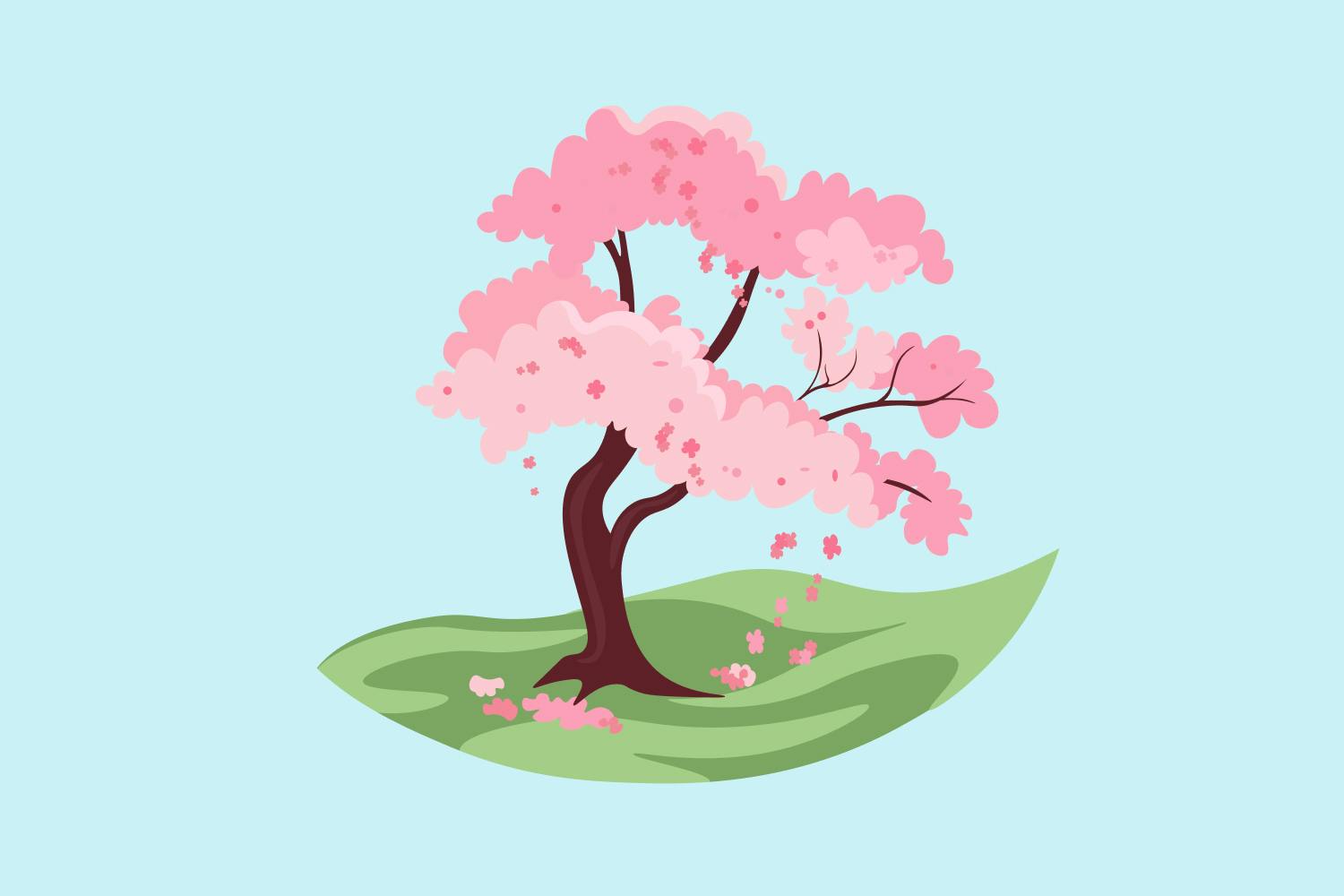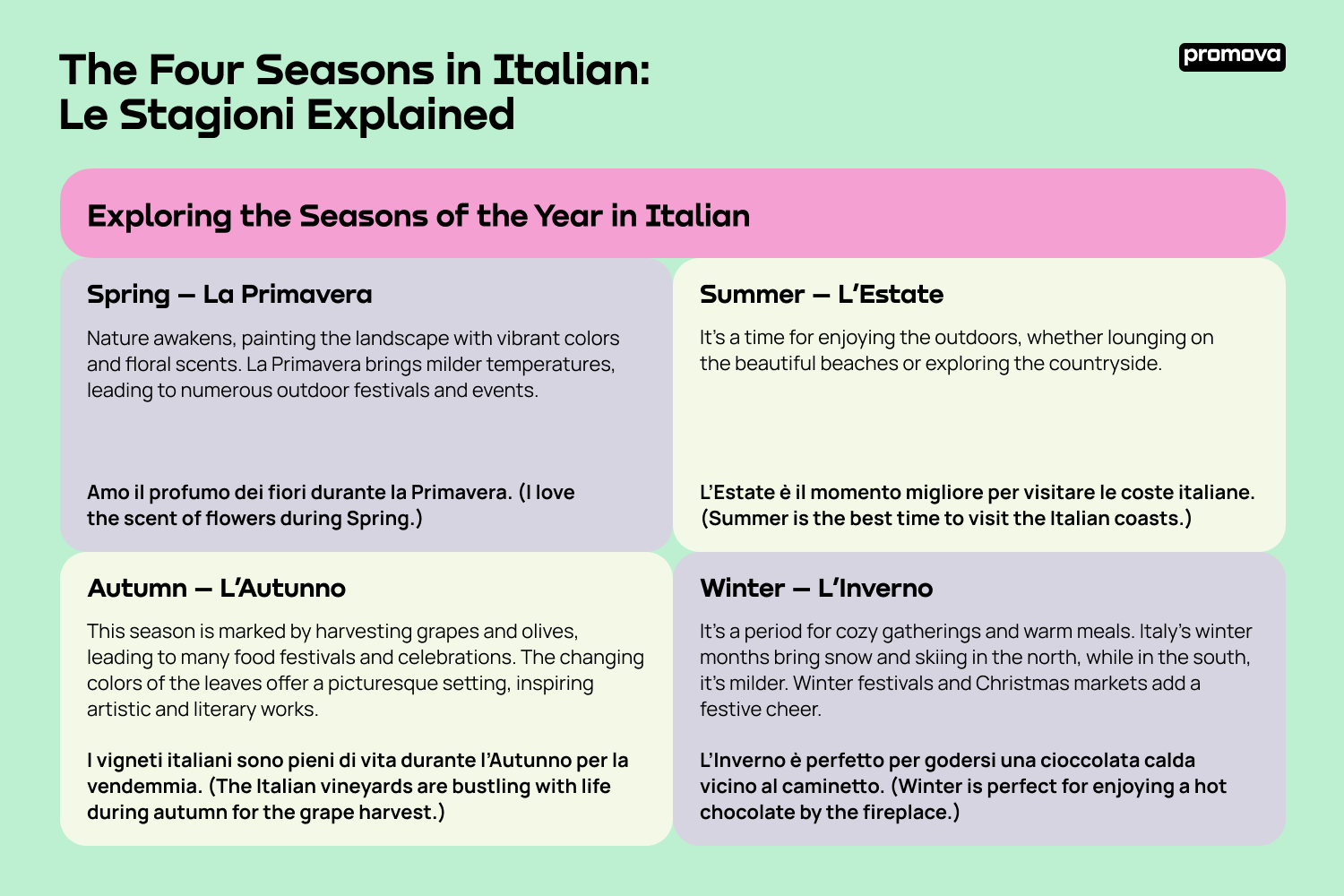The Four Seasons in Italian: Le Stagioni Explained


You will get a promo code with a discount for our app courses after reading this article.
Contents
Every language has unique words and phrases to describe the different times of the year, and Italian is no exception. Understanding how to discuss the seasons in Italian – or Le Stagioni [lɛ sta’dʒoːni] – is vital to learning the tongue. This aspect extends beyond simple translations and encompasses weather-related vocabulary, activities customary for each part of the year, and idiomatic expressions that Italians use in everyday conversation. Read this article and learn more about how to discuss and express the four seasons in Italian.
Exploring the Seasons of the Year in Italian
The rhythm of the year in Italy is deeply connected to its four distinct seasons, each with unique cultural and linguistic nuances. Below is a journey through the Le Stagioni [le staˈdʒoːni]:
- Spring – La Primavera [la primavˈeːra]
Spring in Italy is a time of renewal and celebration. Nature awakens, painting the landscape with vibrant colors and floral scents. La Primavera brings milder temperatures, leading to numerous outdoor festivals and events. This season is often associated with rebirth, romance, and new beginnings in Italian culture, reflected in the language through expressions of growth and rejuvenation.
Amo il profumo dei fiori durante la Primavera. (I love the scent of flowers during Spring.)
La città organizza un grande festival all’aperto con l’arrivo della Primavera. (The city organizes a big outdoor festival with the arrival of Spring.)
- Summer – L’Estate [lɛˈstaːte]
The Italian summer, or L’Estate, is characterized by its warm, sunny days and is often the backdrop for family vacations and seaside escapades. It’s a time for enjoying the outdoors, whether lounging on the beautiful beaches or exploring the countryside. Summer in Italy is synonymous with leisure and relaxation, which is evident in the language’s casual, joyous tone and vibrant festivals celebrating the sun and sea.
L’Estate è il momento migliore per visitare le coste italiane. (Summer is the best time to visit the Italian coasts.)
Adoriamo fare picnic in campeggio durante l’Estate. (We love having picnics while camping during the summer.)
- Autumn – L’Autunno [lauˈtunno]
L’Autunno brings a cooler, more contemplative atmosphere as the summer heat fades. This season is marked by harvesting grapes and olives, leading to many food festivals and celebrations. The changing colors of the leaves offer a picturesque setting, inspiring artistic and literary works. In language, autumn is often associated with nostalgia and reflection, evident in idiomatic expressions and proverbs.
I vigneti italiani sono pieni di vita durante l’Autunno per la vendemmia. (The Italian vineyards are bustling with life during autumn for the grape harvest.)
Le foglie cambiano colore in Autunno, trasformando i paesaggi in quadri pittoreschi. (The leaves change color in Autumn, turning landscapes into picturesque paintings.)
- Winter – L’Inverno [linˈvɛrno]
Winter, or L’Inverno, is a time of stark beauty and introspection. It’s a period for cozy gatherings and warm meals. Italy’s winter months bring snow and skiing in the north, while in the south, it’s milder. Winter festivals and Christmas markets add a festive cheer. With L’Inverno often associated with hearth and home, Italians reflect this through warmth and comfort and the celebration of family traditions.
L’Inverno è perfetto per godersi una cioccolata calda vicino al caminetto. (Winter is perfect for enjoying a hot chocolate by the fireplace.)
Le città italiane si illuminano di luci e decorazioni durante il periodo natalizio. (Italian cities light up with lights and decorations during the Christmas period.)

Useful Phrases about the Four Seasons in Italian
Navigating through Italian requires not just understanding basic grammar and vocabulary but also familiarizing oneself with phrases that are uniquely tied to each season. Rich in cultural context, these expressions offer a glimpse into the Italian way of life as it changes with the seasons. Let’s explore some of these phrases:
- Fa un freddo cane! [fa un ˈfrɛdːo ˈkaːne]
This phrase translates to ‘It’s a dog’s cold!’ and expresses that it’s extremely cold, typically in winter. It’s a vivid way of describing the biting cold one might experience in the Italian winters.
Non dimenticare il cappotto, oggi fa un freddo cane! (Don’t forget your coat, today it’s extremely cold!)
- È tempo di ombrelli [ɛ ˈtɛmpo di omˈbrelli]
Meaning ‘It’s umbrella time,’ this phrase is often used during the rainy spring months. It’s a playful way to acknowledge the need for an umbrella due to the frequent showers.
Aprile è imprevedibile, è tempo di ombrelli. (April is unpredictable; it’s umbrella time.)
- Il caldo è insopportabile [il ˈkaldo ɛ insopporˈtabile]
Translating to ‘The heat is unbearable,’ this phrase is commonly used during the sweltering heat of the Italian summer.
In Agosto, il caldo è insopportabile in città. (In August, the heat is unbearable in the city.)
- I colori dell’autunno sono meravigliosi [i ˈkolori dellauˈtunno ˈsono meraviʎˈʎozi]
It means, ‘The colors of autumn are wonderful.’ It’s a phrase that celebrates the beauty of fall, especially the changing leaves.
Durante una passeggiata nel bosco, i colori dell’autunno sono meravigliosi. (During a walk in the woods, the colors of autumn are wonderful.)
- Una passeggiata primaverile [una passeʤˈdʒata primaveˈrile]
Literally, ‘A spring walk,’ this phrase encapsulates the joy of walking during spring’s fresh, blossoming days.
Domenica faremo una passeggiata primaverile nel parco. (On Sunday, we will take a spring walk in the park.)
- Le notti estive sono magiche [le ˈnɔtti esˈtive ˈsono ˈmaːdʒike]
Meaning ‘Summer nights are magical,’ this phrase captures the enchanting atmosphere of Italian summer evenings.
Sotto il cielo stellato, le notti estive sono magiche. (Under the starry sky, summer nights are magical.)
- Raccogliere le foglie in autunno [rakkoʎˈʎere le ˈfɔʎʎe in auˈtunno]
It translates to ‘Gathering leaves in autumn.’ It’s a phrase that brings to mind the activity of collecting fallen leaves, a common autumnal scene.
I bambini amano raccogliere le foglie in autunno. (Children love gathering leaves in autumn.)
- La neve imbianca tutto [la ˈneːve imbjanˈka ˈtutto]
Meaning ‘The snow whitens everything,’ this phrase describes the landscape transformation during a snowfall.
Quando la neve imbianca tutto, il paesaggio diventa fiabesco. (When the snow whitens everything, the landscape becomes like a fairy tale.)
These phrases enrich your vocabulary and deepen your understanding of the seasonal nuances that are integral to Italian culture and conversation. They will help you connect more authentically with the Italian way of life.
7
Celebration and Festivals Throughout the Seasons in Italy
Italy, known for its rich cultural heritage, celebrates the seasons with various vibrant festivals. Each brings traditional festivities, reflecting the country’s deep historical and cultural roots.
- The arrival of La Primavera [la primavˈeːra] is celebrated with the Infiorata [iɱfjoˈraːta], a flower festival held in various towns. This festival transforms streets into magnificent carpets of intricate floral designs, reflecting the artistry and abundance of spring. Easter, known as Pasqua [ˈpaskwa], is another significant event marked by religious processions and traditional feasts.
- L’Estate [lɛˈstaːte] is a time for outdoor festivities, and Italy bursts into life with numerous events. The Ferragosto [ferraˈɡosto] on August 15th, originally a Roman holiday, is now a nationwide summer vacation period, often marked by beach outings, barbecues, and local festivals. Historical reenactments, like the Palio di Siena [ˈpaljo di ˈsjɛːna], add a glimpse into Italy’s rich past, while music festivals like the Umbria Jazz Festival [ˈumbri.a ˈdʒats ˈfestival] fill the warm nights with melodies.
- With the arrival of L’Autunno [lauˈtunno], Italy celebrates the harvest season. The grape harvest, or Vendemmia [venˈdemmja], is a time-honored tradition, especially in wine-producing regions like Tuscany and Piedmont. Truffle fairs, such as the Alba White Truffle Festival [ˈalba ˈwhite ˈtruffle ˈfestival], offer a taste of Italy’s renowned culinary delights.
- L’Inverno [linˈvɛrno] is a time of enchantment, especially during the Christmas season. The Italian Christmas markets, or Mercatini di Natale [merkaˈtiːni di naˈtaːle], are famous for their festive atmosphere, offering crafts, food, and holiday decorations. The Feast of the Immaculate Conception on December 8th, or L’Immacolata Concezione [limmakoˈlaːta konʧetˈtsjoːne], marks the beginning of the holiday season, followed by lively celebrations on New Year’s Eve, Capodanno [kapoˈdanno].
These celebrations are not just events; they reflect Italy’s diverse cultural landscape, changing beautifully each season. Through these festivities, one experiences the true essence of Italian culture and its rhythms.
Seasonal Foods and Their Names
The cuisine, celebrated for its regional diversity and fresh ingredients, varies significantly with the Italy seasons. Each brings distinctive flavors and specialties deeply rooted in the country’s culinary traditions:
- Spring
Carciofi [karˈtʃoːfi]. Artichokes, often enjoyed in a variety of preparations.
Asparagi [asˈparaɡi]. Asparagus, a versatile vegetable for many dishes.
Fave [ˈfaːve]. Broad beans, typically eaten fresh with pecorino cheese.
Piselli [piˈzɛlli]. Peas, sweet and tender, used in pastas and risottos.
Fragole [ˈfraɡole]. Strawberries, perfect in desserts or salads.
Ravanelli [ravaˈnɛlli]. Radishes, often used in salads for a crunchy, spicy kick.
- Summer
Pomodori [pomoˈdɔːri]. Tomatoes, especially delicious when sun-ripened.
Melanzane [melanˈdzaːne]. Eggplants, a staple in many Mediterranean dishes.
Peperoni [pepeˈroːni]. Bell peppers, colorful and flavorful in various recipes.
Melone [meˈloːne]. Melon, especially refreshing during the hot summer months.
Pesche [ˈpɛske]. Peaches, juicy and flavorful, ideal for desserts.
Anguria [aŋˈɡuːrja]. Watermelon, a quintessential summer fruit.
- Autumn
Funghi [ˈfuɲɲi]. Mushrooms, especially prized varieties like porcini.
Zucca [ˈdzukka]. Pumpkin, used in soups, risottos, and pastas.
Tartufi [tarˈtuːfi]. Truffles, particularly the esteemed white truffles.
Castagne [kasˈtaɲɲe]. Chestnuts, roasted for a traditional autumn treat.
Cavolo Nero [ˈkaːvolo ˈneːro]. Tuscan kale, a staple in hearty soups.
Mele [ˈmɛːle]. Apples, with varieties perfect for baking and snacking.
- Winter
Arance [aˈrantʃe]. Oranges, including the Sicilian blood oranges.
Lenticchie [lenˈtitʃe]. Lentils, traditionally eaten on New Year’s for good luck.
Cavolfiore [ˈkavolˈfjoːre]. Cauliflower, versatile in soups and side dishes.
Cime di Rapa [ˈtʃime di ˈraːpa]. Broccoli rabe, a bitter green often sautéed with garlic.
Cicoria [tʃiˈkoːrja]. Chicory, a leafy green common in winter salads.
Radicchio [raˈdittʃo]. Radicchio, a type of red lettuce, adds color and bite to winter dishes.
Each of these foods not only represents the rich culinary culture of Italy but also embodies the essence of the part of the year in which they are most enjoyed. But no matter what season it is in Italy, the love for food and its role in family and social life remains a constant.
Promova: Efficient Language Learning Awaits
Promova is a language learning platform that offers the tools to improve your proficiency in various tongues. With our array of guided courses, from English to Italian to German, you will gain knowledge through engaging vocabulary lessons, detailed grammatical insights, and quizzes designed to reinforce your learning.
For those focusing on English, take advantage of our 1x1 lessons available through the app and web platforms. There’s no need to wait – sign up today and receive a free trial lesson with our expert English tutors. These personalized sessions are designed to zero in on your specific learning needs.
Additionally, Promova hosts a Conversation Club exclusively on the web for English learners. This club allows you to practice speaking skills and meet language learners from around the globe. Participation in the Conversation Club is completely free, making it an excellent supplement to your learning regimen.
To further support your language development, we encourage you to explore our blog and follow us on social media. It is a rich resource, with articles that provide valuable insights into learning strategies and cultural nuances. You can learn how to tell time in Italian, understand French idioms, and so much more.
Conclusion
Exploring the seasons in Italian offers a vivid glimpse into the heart of Italian culture. Each one, from the blossoming beauty of La Primavera to the cozy embrace of L’Inverno, paints a unique portrait of Italy’s rich heritage. Whether learning seasonal phrases, participating in traditional festivals, or savoring delicacies, embracing the rhythm of Italian seasons enriches our understanding and appreciation of this beautiful language.
Use your discount and learn languages with Promova
Start learningFAQ
Is there a difference in seasonal celebrations between northern and southern Italy?
Yes, there’s a notable difference. Northern Italy has more winter-focused celebrations, like skiing festivals and Christmas markets. Southern Italy, benefiting from a milder climate, often has vibrant spring and summer festivals focusing on seaside and agricultural celebrations.
Can learning about Italian seasons enhance language proficiency?
Yes, learning about Italian seasons can significantly enhance language proficiency. Understanding such vocabulary and expressions provides context to conversations and cultural references. It also offers insights into idiomatic expressions and sayings related to different times of the year.
What is an effective method for memorizing seasonal vocabulary in Italian?
A practical method for memorizing vocabulary is to create a thematic learning approach. Start by categorizing words based on 4 seasons in Italian – spring, summer, autumn, and winter. Use flashcards with the Italian word on one side and its meaning or a related image on the other. This visual association helps in better retention.
Are there other resources for learning seasonal vocabulary in Italian?
Several online resources are invaluable for those looking to expand their Italian vocabulary. WordReference provides an extensive dictionary with examples and forums for context. Also, Larousse offers translation tools that include phrases and idiomatic expressions. The Italian language-learning app by Promova is also an excellent resource for expanding your vocabulary.



Comments